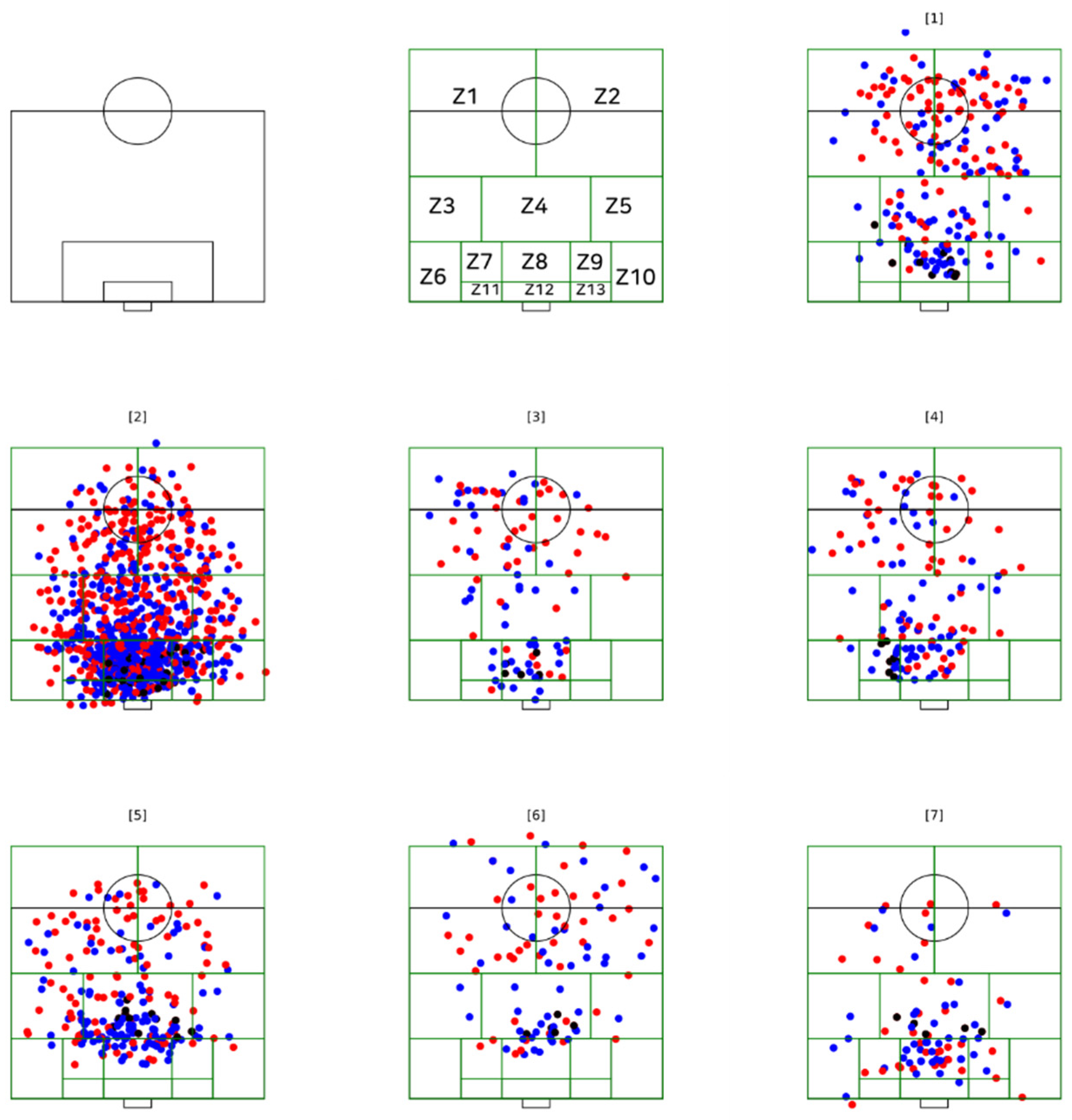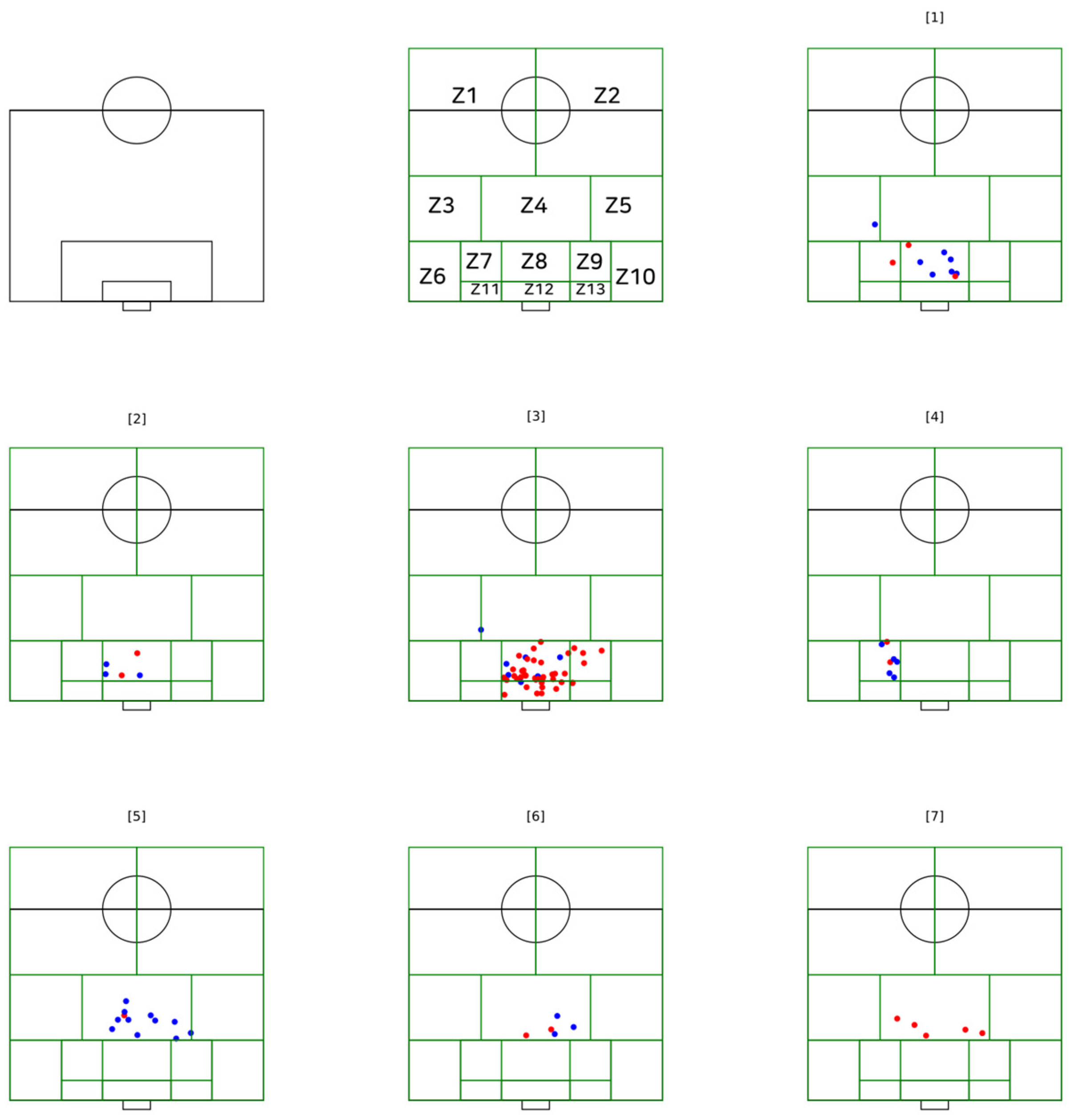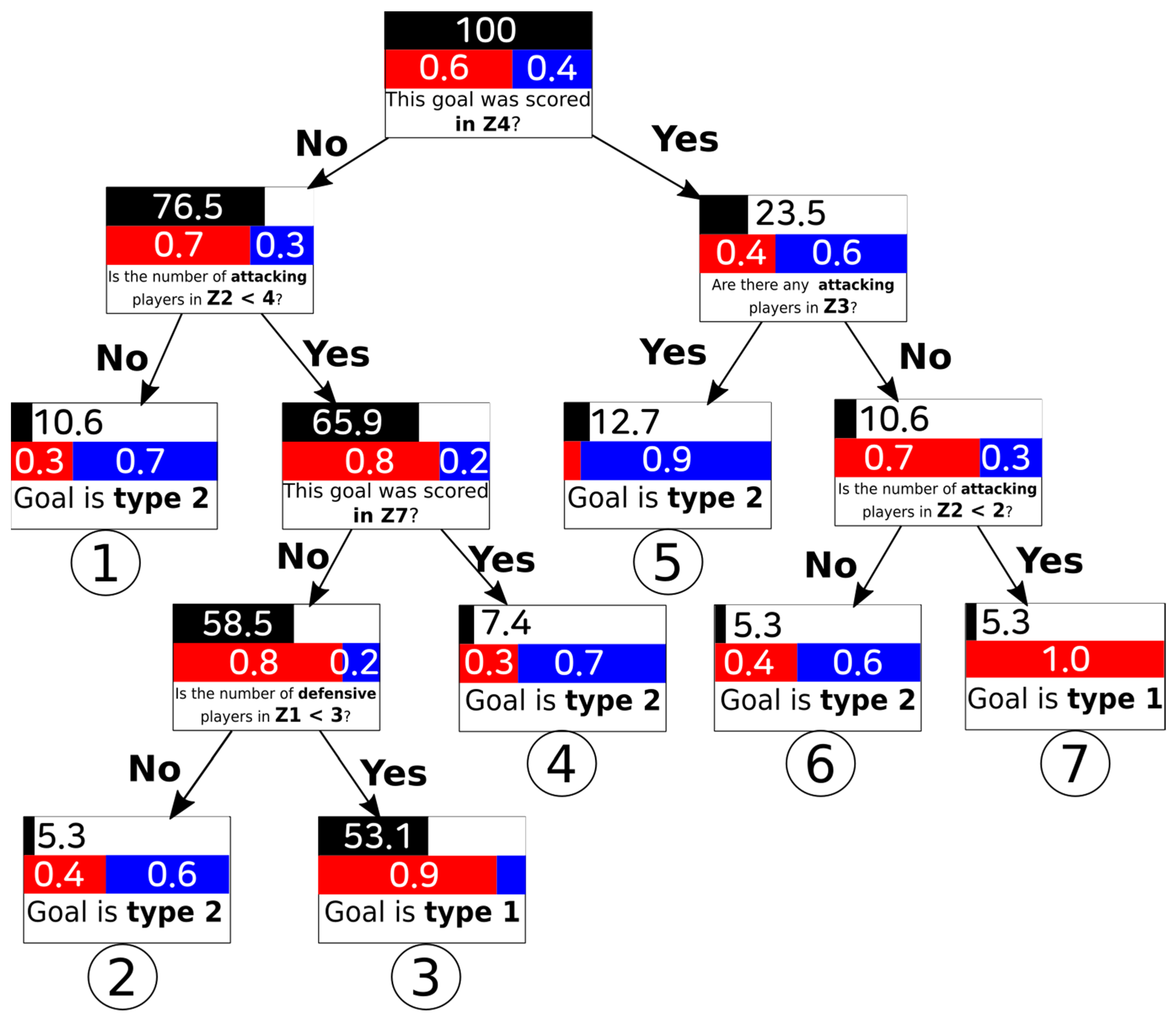Characterisation of Goal Scoring Patterns during Open Play Related to Zone Pitch Division and Number of Players Involved in the 2018 FIFA World Cup
Abstract
:1. Introduction
2. Materials and Methods
2.1. Match Sample and Data Source
2.2. Performance Variables
- Team possession type: Degree of offensive directness by the level of utilisation or the creation of imbalances in the opponent’s defence to achieve penetration (how quickly penetration is attempted after winning the ball). Penetration is achieved when a pass goes towards the opponent’s goal, past the opponent player(s), while the attacker(s) maintain a high degree of control over the ball. (i) A counterattack (‘direct play’) starts with winning the ball in play and progresses by either (a) utilising or attempting to utilise a degree of imbalance from start to end or (b) creating or attempting to create a degree of imbalance from start to end by using an early (first or second, evaluated qualitatively) penetrative pass or dribble. Utilising a degree of imbalance means seeking penetration in such a way that the defending team will fail to regain a high degree of balance from the start to the end of the attacking team’s possession. Counterattacks progress relatively quickly. (ii) An elaborate attack (‘possession play’) starts with winning the ball in play and progresses either (a) without utilising or attempting to utilise a degree of imbalance or (b) by creating or attempting to create a degree of imbalance by using a late (third or later, evaluated qualitatively) penetrative pass or dribble. Not utilising a degree of imbalance means seeking penetration in such a way that a defending team manages to regain a high degree of balance before the end of the attacking team’s possession. Elaborate attacks often progress relatively slowly [20].
- Space of use (pitch zone): The pitch was divided into 13 zones (from Z1 to Z13), splitting the pitch into four transversal zones parallel to the halfway and goal lines using six horizontal lines (see Figure 1). The pitch zones were adapted from the traditional nine-zone pitch division in accordance with Grehaigne et al. [21] to ensure sufficient accuracy of the zone code, where any spatial pitch zone is related to goal scoring (the last action performed by the player scoring the goal at the moment of shooting).
- Number of players involved, measured by the number of players occupied in relation to the pitch zone from where a goal was scored: The number of players participating (attackers and defenders) on each team at the time when each goal was scored.
2.3. Reliability Testing
2.4. Procedure and Statistical Analysis
3. Results
4. Discussion
5. Practical Implications
6. Conclusions
Author Contributions
Funding
Institutional Review Board Statement
Informed Consent Statement
Data Availability Statement
Conflicts of Interest
References
- Ottenfeld, M.; Poremba, E.K.; Haug, R. What’sa Qatar? FIFA World Cup 2022. J. Mark. Manag. 2019, 7, 1–11. [Google Scholar]
- FIFA. 2018 FIFA World Cup Russia™. Global Broadcast and Audience Summary. Available online: https://resources.fifa.com/image/upload/2018-fifa-world-cup-russia-global-broadcast-and-audience-executive-sumary.pdf?cloudid=njqsntrvdvqv8ho1dag5 (accessed on 22 December 2020).
- Acar, M.; Yapicioglu, B.; Arikan, N.; Yalcin, S.; Ates, N.; Ergun, M. Analysis of goals scored in the 2006 World Cup. In Science and Football VI; Routledge: London, UK, 2009; pp. 261–268. [Google Scholar]
- Castellano, J.; Alvarez-Pastor, D.; Bradley, P.S. Evaluation of research using computerised tracking systems (Amisco® and Prozone®) to analyse physical performance in elite soccer: A systematic review. Sports Med. 2014, 44, 701–712. [Google Scholar] [CrossRef]
- Bradley, P.S.; Carling, C.; Diaz, A.G.; Hood, P.; Barnes, C.; Ade, J.; Boddy, M.; Krustrup, P.; Mohr, M. Match performance and physical capacity of players in the top three competitive standards of English professional soccer. Hum. Mov. Sci. 2013, 32, 808–821. [Google Scholar] [CrossRef]
- Sarmento, H.; Marcelino, R.; Anguera, M.T.; CampaniÇo, J.; Matos, N.; LeitÃo, J.C. Match analysis in football: A systematic review. J. Sports Sci. 2014, 32, 1831–1843. [Google Scholar] [CrossRef] [Green Version]
- Higham, D.G.; Hopkins, W.G.; Pyne, D.B.; Anson, J.M. Performance indicators related to points scoring and winning in international rugby sevens. J. Sports Sci. Med. 2014, 13, 358. [Google Scholar]
- McGarry, T.; Anderson, D.I.; Wallace, S.A.; Hughes, M.D.; Franks, I.M. Sport competition as a dynamical self-organizing system. J. Sports Sci. 2002, 20, 771–781. [Google Scholar] [CrossRef]
- McCall, A.; Davison, M.; Andersen, T.E.; Beasley, I.; Bizzini, M.; Dupont, G.; Duffield, R.; Carling, C.; Dvorak, J. Injury prevention strategies at the FIFA 2014 World Cup: Perceptions and practices of the physicians from the 32 participating national teams. Br. J. Sports Med. 2015, 49, 603–608. [Google Scholar] [CrossRef] [PubMed] [Green Version]
- Dvorak, J.; Junge, A.; Derman, W.; Schwellnus, M. Injuries and illnesses of football players during the 2010 FIFA World Cup. Br. J. Sports Med. 2011, 45, 626–630. [Google Scholar] [CrossRef] [Green Version]
- Castellano, J.; Casamichana, D.; Lago, C. The use of match statistics that discriminate between successful and unsuccessful soccer teams. J. Hum. Kinet. 2012, 31, 137–147. [Google Scholar] [CrossRef] [PubMed]
- Moura, F.A.; Martins, L.E.B.; Cunha, S.A. Analysis of football game-related statistics using multivariate techniques. J. Sports Sci. 2014, 32, 1881–1887. [Google Scholar] [CrossRef] [PubMed]
- Gómez, M.-Á.; DelaSerna, A.; Lupo, C.; Sampaio, J. Effects of Situational Variables and Starting Quarter Score in the outcome of elite women’s water polo game quarters. Int. J. Perform. Anal. Sport 2014, 14, 73–83. [Google Scholar] [CrossRef]
- Sampaio, J.; Lago, C.; Casais, L.; Leite, N. Effects of starting score-line, game location, and quality of opposition in basketball quarter score. Eur. J. Sport Sci. 2010, 10, 391–396. [Google Scholar] [CrossRef]
- Yiannakos, A.; Armatas, V. Evaluation of the goal scoring patterns in European Championship in Portugal 2004. Int. J. Perform. Anal. Sport 2006, 6, 178–188. [Google Scholar] [CrossRef]
- Mahony, L.E.; Wheeler, K.W.; Lyons, K. Analysis of Factors Determining Invasion into Attacking Areas and the Creation of Goal-Scoring Opportunities in the Asian Cup Football Competition. Asian J. Exerc. Sports Sci. 2012, 9, 53–66. [Google Scholar]
- Hughes, M.; Franks, I. Analysis of passing sequences, shots and goals in soccer. J. Sports Sci. 2005, 23, 509–514. [Google Scholar] [CrossRef]
- Armatas, V.; Yiannakos, A.; Sileloglou, P. Relationship between time and goal scoring in soccer games: Analysis of three World Cups. Int. J. Perform. Anal. Sport 2007, 7, 48–58. [Google Scholar] [CrossRef]
- Puig-Diví, A.; Escalona-Marfil, C.; Padullés-Riu, J.M.; Busquets, A.; Padullés-Chando, X.; Marcos-Ruiz, D. Validity and reliability of the Kinovea program in obtaining angles and distances using coordinates in 4 perspectives. PLoS ONE 2019, 14, e0216448. [Google Scholar] [CrossRef]
- Tenga, A.; Holme, I.; Ronglan, L.T.; Bahr, R. Effect of playing tactics on achieving score-box possessions in a random series of team possessions from Norwegian professional soccer matches. J. Sports Sci. 2010, 28, 245–255. [Google Scholar] [CrossRef]
- Gréhaigne, J.; Marchal, D.; Duprat, E. l7 Regaining Possession of the ball in the defensive area in soccer. In Science and Football IV; Routledge: London, UK, 2001; p. 112. [Google Scholar]
- O’Donoghue, P. An Introduction to Performance Analysis of Sport; Routledge: London, UK, 2014. [Google Scholar]
- Altman, D.G. Practical Statistics for Medical Research; CRC Press: Boca Raton, FL, USA, 1990. [Google Scholar]
- Cohen, J. Statistical Power Analysis for the Behavioral Sciences; Academic Press: London, UK, 2013. [Google Scholar]
- Kubayi, A. Analysis of goal scoring patterns in the 2018 FIFA World Cup. J. Hum. Kinet. 2020, 71, 205–210. [Google Scholar] [CrossRef] [Green Version]
- Wright, C.; Atkins, S.; Polman, R.; Jones, B.; Sargeson, L. Factors associated with goals and goal scoring opportunities in professional soccer. Int. J. Perform. Anal. Sport 2011, 11, 438–449. [Google Scholar] [CrossRef]
- Njororai, W.W.S. Downward trend of goal scoring in world cup soccer tournaments (1930 to 2010). J. Coach. Educ. 2013, 6, 111–120. [Google Scholar] [CrossRef] [Green Version]
- Oberstone, J. Differentiating the top English premier league football clubs from the rest of the pack: Identifying the keys to success. J. Quant. Anal. Sports 2009, 5, 10. [Google Scholar] [CrossRef] [Green Version]
- Cachay, K.; Thiel, A. Soziologie des Sports; Juventa-Verlag: Munich, Germany, 2000. [Google Scholar]
- Smith, R.A.; Lyons, K. A strategic analysis of goals scored in open play in four FIFA World Cup football championships between 2002 and 2014. Int. J. Sports Sci. Coach. 2017, 12, 398–403. [Google Scholar] [CrossRef]
- Ric, A.; Torrents, C.; Gonçalves, B.; Torres-Ronda, L.; Sampaio, J.; Hristovski, R. Dynamics of tactical behaviour in association football when manipulating players’ space of interaction. PLoS ONE 2017, 12, e0180773. [Google Scholar] [CrossRef] [PubMed] [Green Version]
- Gómez, M.A.; Gómez-Lopez, M.; Lago, C.; Sampaio, J. Effects of game location and final outcome on game-related statistics in each zone of the pitch in professional football. Eur. J. Sport Sci. 2012, 12, 393–398. [Google Scholar] [CrossRef]
- Mclean, S.; Salmon, P.M.; Gorman, A.D.; Stevens, N.J.; Solomon, C. A social network analysis of the goal scoring passing networks of the 2016 European Football Championships. Hum. Mov. Sci. 2018, 57, 400–408. [Google Scholar] [CrossRef]




Publisher’s Note: MDPI stays neutral with regard to jurisdictional claims in published maps and institutional affiliations. |
© 2021 by the authors. Licensee MDPI, Basel, Switzerland. This article is an open access article distributed under the terms and conditions of the Creative Commons Attribution (CC BY) license (https://creativecommons.org/licenses/by/4.0/).
Share and Cite
Cerda, J.; Sanchez-Sanchez, J.; Viejo-Romero, D.; Jimenez-Linares, L.; Gimenez, J.V.; Garcia-Unanue, J.; Felipe, J.L. Characterisation of Goal Scoring Patterns during Open Play Related to Zone Pitch Division and Number of Players Involved in the 2018 FIFA World Cup. Sensors 2021, 21, 5601. https://doi.org/10.3390/s21165601
Cerda J, Sanchez-Sanchez J, Viejo-Romero D, Jimenez-Linares L, Gimenez JV, Garcia-Unanue J, Felipe JL. Characterisation of Goal Scoring Patterns during Open Play Related to Zone Pitch Division and Number of Players Involved in the 2018 FIFA World Cup. Sensors. 2021; 21(16):5601. https://doi.org/10.3390/s21165601
Chicago/Turabian StyleCerda, Joaquin, Javier Sanchez-Sanchez, David Viejo-Romero, Luis Jimenez-Linares, Jesus Vicente Gimenez, Jorge Garcia-Unanue, and Jose Luis Felipe. 2021. "Characterisation of Goal Scoring Patterns during Open Play Related to Zone Pitch Division and Number of Players Involved in the 2018 FIFA World Cup" Sensors 21, no. 16: 5601. https://doi.org/10.3390/s21165601
APA StyleCerda, J., Sanchez-Sanchez, J., Viejo-Romero, D., Jimenez-Linares, L., Gimenez, J. V., Garcia-Unanue, J., & Felipe, J. L. (2021). Characterisation of Goal Scoring Patterns during Open Play Related to Zone Pitch Division and Number of Players Involved in the 2018 FIFA World Cup. Sensors, 21(16), 5601. https://doi.org/10.3390/s21165601








